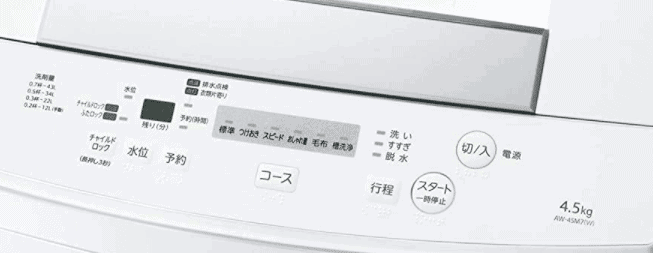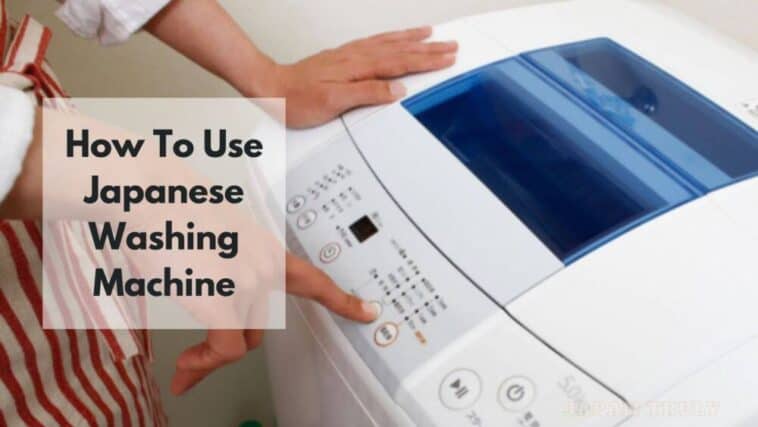Moving to Japan comes with its own challenges but doing your laundry shouldn’t be one of them. So here’s how to use Japanese washing machine like a pro!
Don’t be intimidated by those Japanese washing machine symbols! This guide unlocks the secrets to laundry mastery. Learn about common cycles, decipher detergent & softener dispensers, and conquer washing woes. Get ready to transform your laundry routine and become a Japanese washing machine pro!
Page Contents
How to use a Japanese washing machine?
To use a Japanese washing machine, hit 入 button to turn it on then press 水量 and select your desired water level. Hit the コース and select the desired course you want the machine to wash your clothes in. After that, add detergent and close the lid. Finally press スタートto start the washing machine to wash your clothes.
You don’t have to know kanji to learn how to use Japanese washing machine but if you can just recognise a few Japanese words you can work a Japanese washing machine easily.

I’ll list those words for you along with its English translation and also give you a step-by-step instruction on how to use Japanese washing machine.
How To Use Japanese Washing Machine
A standard Japanese washing machine is a top-loading washing machine. These models are fairly cheaper when compared to the Japanese front-loading washing machines.
But you should also consider that top-loading washing machines use more water when compared to front-loading ones per wash. And your clothes might be wrinkled more than it should be when the machine is done with it.
Take a closer look at this top loading washing machine’s control panel.

Now, because you see all that kanji written, it might seem complicated. But relax, it’s pretty easy. You just have to figure out the basic settings and you’ll be able to use most Japanese washing machines there on forward.
- Related: Japanese For Washing Machines And Dryers
- Related: How To Use A Japanese Toilet 101
- Related: How To Use Japanese Air Conditioners 101
How To Use Japanese Washing Machine: Quick Glance
- Step 1: Hit the button 入 to turn it on
- Step 2: Press 水量 to select the desired water volume
- Step 3: Press コース to select the desired course
- Step 4: Add the detergent
- Step 5: Close the lid
- Step 6: Press スタート to start the washing process
Japanese Washing Machine Buttons in Kanji Translated
| Japanese | English Translation | Transliteration |
| 電源 | Power | dengen |
| スタート | Start | sutaato |
| 一時停止 | Stop | ichijiteishi |
| 入 | On | Iri |
| 切 | Off | Kiri |
| おまかせ | Automatic | omakase |
| お急ぎ | Speed wash | oisogi |
| 香りしっかり | Fragrance saver | kaori shikkari |
| すすぎ1回 | One rinse cycle | susugi ikka |
| 洗い | Wash | arai |
| つけおき | Soak | tsukeoki |
| 脱水 | Dry | dassui |
| すすぎ | Rinse | susugi |
| 送風乾燥 | Drying | soufuukansou |
| 毛布 | Blanket | moufu |
| 手洗い | Handwash/Delicates | tearai |
| 槽カビ予防 | Washing basin mold prevention | ukekabiyobou |
| 槽洗浄 | Washing basin cleaning | ukesenjyou |
| 予約 | Timer | yoyaku |
| 3時間 | Three hours | sanjikan |
| 残り(約)分 | Time remaining (approx.) min | nokori (yaku) bun |
| 時間後 | …hours later | jikango |
| コース | Course | kousu |
| 行程 | Cycle | koutei |
| 水量 | Water volume | suiryou |
| チャイルドロック | Child lock | chairudorokku |
| ふたロック | Cover lock | futarokku |
Not every Japanese washing machine will have all of these buttons but if you get a hang of this vocabulary you can ideally run any Japanese washing machine without a problem. Some kanji words aren’t translated literally because the meaning slightly differs due to context.
Here’s a brief of all the Japanese washing buttons you need to know. You’ll understand what the different settings mean and when you’d want to use them, helping you understand how to use Japanese washing machine better!
Automatic: This is the basic washing cycle and is suitable for most clothes. To start, press the power button and then press スタート, and leave the rest to the washing machine.
One rinse cycle: Usually, there are two runce cycles involved per wash before the dryer starts. Choosing this function, the washing machine will perform only one rinse cycle.
Fragrance saver: Once the washing machine has washed your clothes with the detergent, you can add your favorite fabric softener. The washing machine will make a sound when it’s time to add the fabric softener.
Speed wash: This is a quick washing cycle. You can use this setting when your clothes aren’t all that dirty and you don’t have a full load. The spin cycle in this setting is shorter so it’ll be done within an hour.
Soak: Use this setting if your clothes have tough stains on them. The washing machine will prolong the soaking time so the stains are easier to wash off.
Blankets: Since blankets are heavy and thick, the washing machine will draw in more water and the washing cycle will also be longer.
Delicates: Use this setting when you wash your undergarments. Since these pieces of clothing are smaller and made of soft fabric, the washing machine adjusts how the clothes are rotated and also shortens the drying time.
Washing basin mold prevention: Go through your washing machine’s manual and look for a bleach that’s approved by the manufacturer.
Washing basin cleaning: The washing machine manual should also mention the approved washing machine cleaner. Use this to clean the insides of the basin of the washing machine.
Ventilation drying: This is to dry your clothes before you take it out of the washing machine.
If you don’t want to set the water level or select a course, just hit the automatic button and press start!
Once the washing machine is done with your clothes, it’s time to dry it. You have two options here – you can air dry it or use a dryer. Using a dryer, however, will take up too much electricity and in my opinion it isn’t a worthy investment.
You can easily get a clothes drying rack, spinning circular racks or even with hundred clips. You can choose one depending on how much space you have and your drying needs.
During winter it can get a little difficult to dry your clothes because it’ll take longer. For emergency situations you can hit a laundromat as well.
For about 10-20 minutes of using the dryer, it’ll cost you around 100 yen.
And if you’re someone who does laundry multiple times a week, you can see how this option isn’t the most cost-effective in the long run.
Other than this, if you want to dry the clothes inside the house on a rainy day then you can use a dehumidifier for wet clothes to keep your laundry room fresh and avoid the damp smell that comes with hanging wet clothes inside the house.
This beautiful island nation is full of surprises, unspoken rules, and other cultural challenges. But how to use a Japanese washing machine should be the least of your concerns.
How to dry clothes in Japanese washing machine?
Using a Japanese washing machine might have some differences compared to washing machines in other countries. Here’s a quick guide on how to use a typical Japanese washing machine:
- Sorting Clothes: Separate your clothes based on their colors and fabric types. Most machines in Japan have settings for different fabric types and colors, so it’s important to sort your clothes accordingly.
- Loading Clothes: Open the washing machine door and load your clothes into the drum. Be careful not to overload the machine, as it can affect the washing efficiency.
- Detergent: Add the appropriate amount of detergent to the detergent tray. If you’re unsure about the amount, check the detergent packaging for guidance. Some machines might have specific compartments for pre-wash and main wash detergents.
- Selecting a Wash Cycle: Most Japanese washing machines have a control panel with buttons and a digital display.
- Look for the button labeled “洗濯コース” (Sentaku Kōsu) or something similar, which means “Wash Cycle.” Press this button to cycle through different wash programs.
Common options include:- Standard (標準)
- Delicate (手洗い)
- Quick Wash (短時間)
- Heavy Duty (おおはた)
- Eco Wash (エコ)
- Temperature and Spin Speed: Depending on the wash cycle, you might have the option to adjust the water temperature and spin speed. Use the buttons labeled “温度” (Ondo) for temperature and “脱水” (Dassui) for spin speed to make your selections.
- Additional Options: Some machines offer additional options like extra rinses, gentle wash, and soak. These can be selected using corresponding buttons on the control panel.
- Start the Wash: Once you’ve selected the desired wash cycle and settings, press the “スタート” (Start) button to begin the wash cycle. The machine will fill with water, agitate the clothes, drain the water, and proceed through the wash process.
- End of Cycle: When the wash cycle is complete, the machine might play a musical chime or display a message. Open the door, take out your clean clothes, and shake them out a bit to reduce wrinkles.
- Cleaning the Machine: It’s a good practice to clean the washing machine’s drum and detergent tray periodically to prevent mold and mildew growth. Some machines have a self-cleaning cycle you can run.
Do Japanese washing machines use hot water?
Japanese washing machines only use cold water to wash the clothes and are very small in size.
Why are washing machines so expensive in Japan?
Smaller stores are better than big stores in terms of prices but usually, Japan has a very high price for a washing machine due to both the manufacturers and the government.
What washing machines are made in Japan?
There are a lot of electronics brands that make washing machines in Japan. Hitachi occupies the first place in the market, followed by Panasonic, Toshiba and Sharp. Whirlpool and Heir are not so commonly used in Japan.
Do Japanese homes have washing machines?
Most Japanese houses now have washing machines. If not that, they’ll at least have a dryer because most of them dry out on their balcony or in the washroom. However, you can find a lot of laundromats in Japan who can solve your problem at a minimal price.
Also Read:
- Here’s how you can buy tickets to the SUMO match in Tokyo!
- Keep your home squeaky clean with these amazing Japanese cleaning products!





